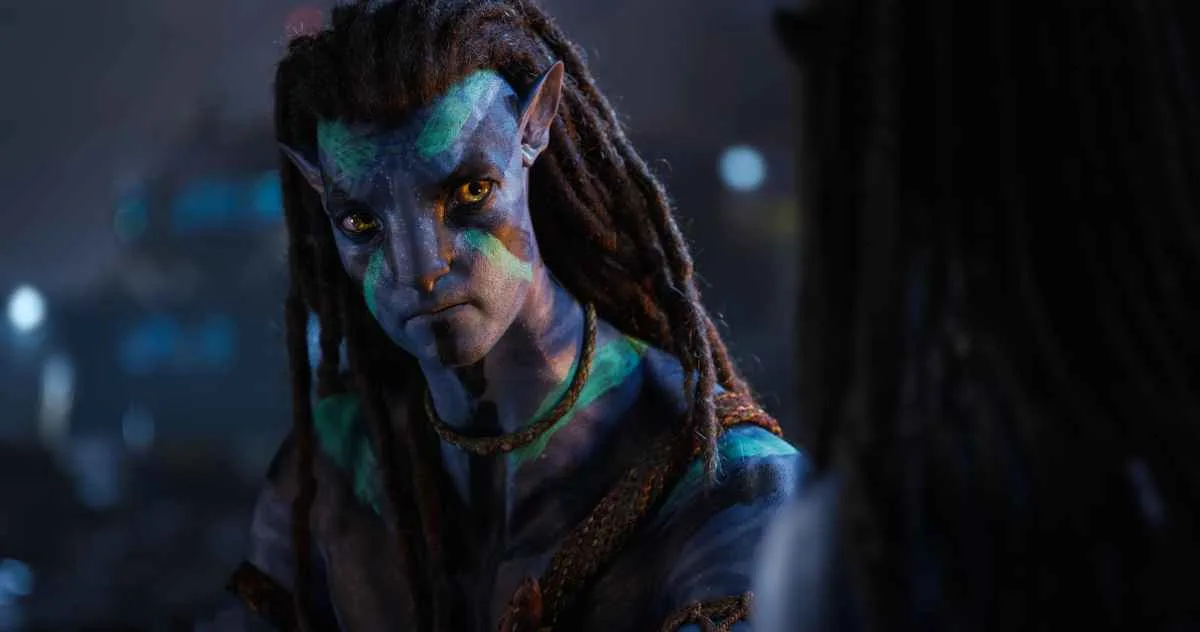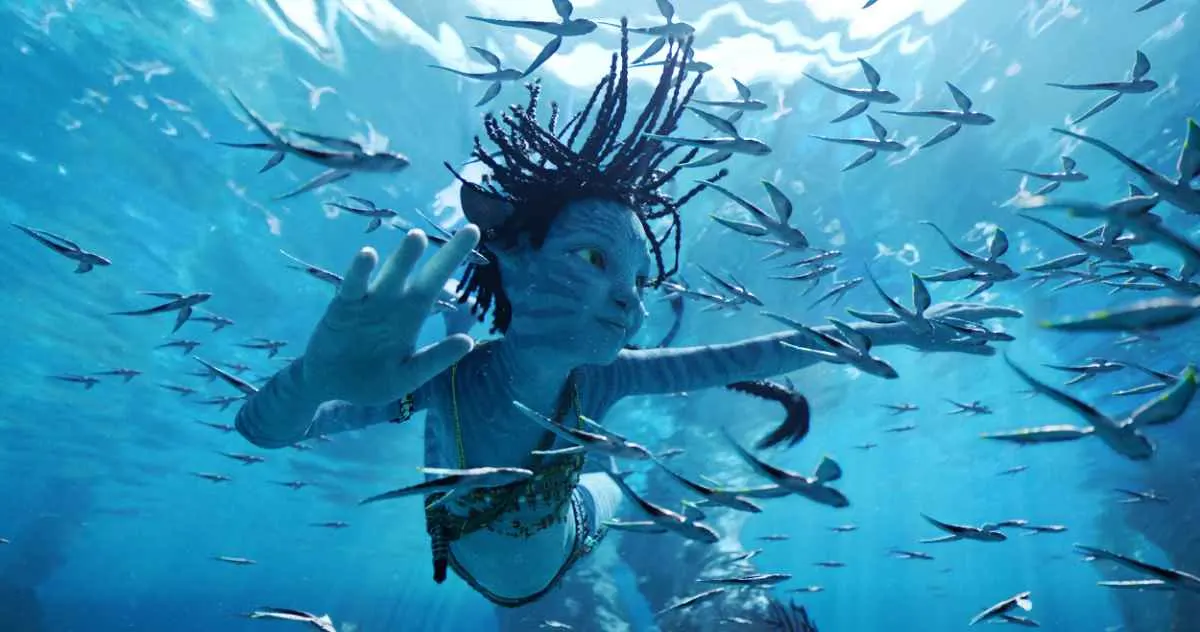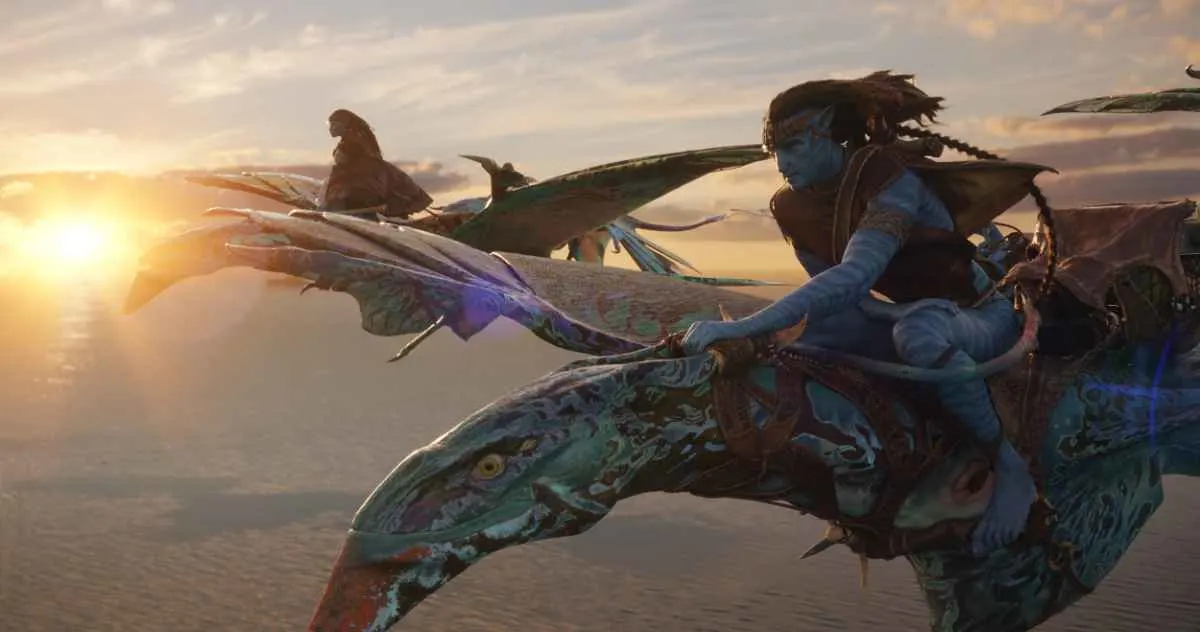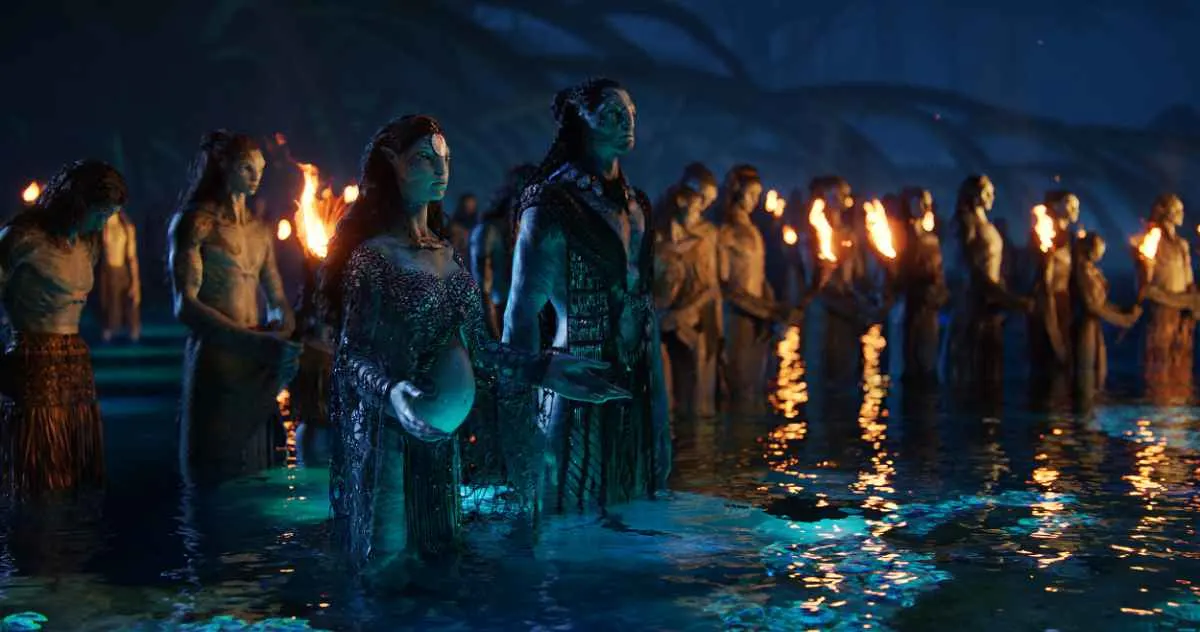Roughly halfway through the 192-minute running time of Avatar: The Way of Water we watch young Kiri (Sigourney Weaver), the semi-messianic miracle child of Weaver’s previous character Dr. Grace Augustine, staring at a crab hole under the water, lost in the miracle of nature to the point all conception of time and space has faded away.
Why she does this is unclear and never explained but also beside the point for the filmmakers whose focus is entirely on that pinprick of a nature that doesn’t really exist. This is very much what the experience of watching the long-in-the-making Avatar sequel is like.

Brilliantly designed and produced, but narratively muddled, James Cameron’s Avatar: The Way of Water creates a world on screen that lives and breathes on its own separate from anything its audience or characters experience, particularly in high frame rate 3D IMAX.
If one of the major remits of cinema as an art form is to create a mise en scène that an audience can fall into and believe in no matter what it shows then Way of Water is the ne plus ultra of the form, achieving the false realism every director since the Lumière brothers has chased after. Expanding on both the world he created in the first Avatar and the threats to it, Cameron’s attention to detail on the ecosystem of Pandora (and how everyone is a part of it) is so minute it draws the viewer into it almost against their own will.

As many years as have passed for us in cinemas have passed for marine-turned-Na’vi Jake Sully (Sam Worthington), who has taken the opportunity since mankind was cast off Pandora to begin raising a small clan of children with chieftain’s daughter Neytiri (Zoe Saldaña) and begun settling into life as a leader and father. Like the 19th Century American plains, momentary colonial retreat is only ever that… eventually the settlers return, this time with hydrofoils and crab subs and their own army of cloned Na’vi avatars to stake their claim on the planet.
Taking up the mantle of resistance leader again, Sully soon finds his family targeted by the enemy in order to put pressure on him and decides discretion really is the better part of valor, taking his wife and children and fleeing their flying home for the safety of the ocean where they join the water-based clan on the life-covered reefs of Pandora’s ocean and begin learning a new way of life far from the grasping claws of humanity. Or so they think.

If that feels like a pretense to get out to the ocean and start delving into a new portion of Pandora’s treasures, that’s because it is but the treasures are rich enough that viewers may not care. Cameron’s love of the water and undersea exploration is well-known and explodes into vibrant life in Way of Water, as the Sully clan learns to ride underwater horses and delve into the glowing realms of undersea fauna.
It opens up Cameron and his production designers, Dylan Cole and Ben Procter (replacing Rick Carter and Robert Stromberg from the original), to create a beautiful fluorescent world of three-mouthed sharks and armored whales.

They’re not the only new arrivals to the world of Avatar, with many of the first film’s original collaborators replaced over the years, particularly composer James Horner who sadly passed away in the intervening years. In his place is Simon Franglen, Horner’s long-time arranger, who focuses on repeating what came before without changing or expanding it.
Fortunately, as a visual experience Way of Water rarely falls into that trap. It is clearly still of a piece with the first film but it is also clear Cameron, who has always had a poets grasp on cinematic visuals even as he delves into increasing epic grandeur, can still conjure a visual gem without repeating himself.

But there are flaws in the diamond. While the first Avatar was, fairly, critiqued for its cliched plot and often overly macho dialogue it was also very straight forward, carrying character and audience along with speed and verve: a soldier joins a new culture and fights for it against his old masters. Cameron has always been primarily a visual storyteller and wisely kept his stories as simple and uncomplex as possible – bare frames to hang his set pieces on.
Titanic is about two people falling in love against the backdrop of a great disaster, the Terminator films are about fighting robots from the future to save humanity, True Lies is about Arnold Schwarzenegger chasing a motorcycle on a horse, etc.

The Way of Water is about Jake Sully giving up the good fight to care for his family only to discover that the fight can never be fully escaped. Or its about his youngest son, Lo’ak (Britain Dalton), trying to find his own identity separate from his family and out of the shadow of his legendary father and more disciplined older brother (Jamie Flatters). Or its about Kiri’s quest to find out how she came to be and what her strange connection to the Pandoran environment means.
Or its about the resurrected Col. Quaritch’s (Stephen Lang, far less interesting even as he becomes more complex) hunt for Sully even as he reconnects with the son who was left behind (Jake Champion) when he died in the first film and grew up alongside his enemies. Or its about… a lot of other things. Cameron has expanded his cast and his ambitions dramatically but has ended up with the most muddled storytelling of his career.

The extended amount of time spent with Lo’ak as he deals with his feelings of isolation and bonds with the creatures of the sea marks him as a, if not the, primary point of view character but Sully remains the first person narrator relating everything to his personal experience even when he’s not the one experiencing things, for no obvious reason beyond it being the structure of the first film.
He also disappears for most of the extended middle only to reappear and yank the film back to himself during the climax when its time to start fighting bad guys again, robbing the final confrontation of emotion because it bends to a character we haven’t been focused on rather than the one we have.

It introduces our newest villain, The Sopranos‘ Edie Falco, as a general with the remit to colonize Pandora as the new home for humans after ecological collapse on Earth, only to forget her in place of a crazed whaler who reveals (in a nearly 30-minute whaling sequence that seems to only exist to explain the geography of the action finale) that the real reason humans are back is to harvest a material from the whales that makes humans immortal. Each of these piece’s steps on each other, dragging out pacing but offering little to hang on to beyond visuals.
Perhaps it’s a side effect of the sequel’s long gestation and search for a good idea for a follow up; perhaps it’s the inevitable outcome of switching to a television-like writer’s room focused on telling a story across multiple sequels and working as a group to figure out a story as opposed to a single auteur’s creative impulse; perhaps it’s the need to set up said future films at the expense of dramatic structure in the here and now. Perhaps its all of the above. The Way of Water is about being a sequel to Avatar, but little beyond that is clear.

If half of the purpose of cinema is to create a visual reality we can momentarily believe in, the other half is to tell stories. One without the other is only serving half of our need. No matter how much the film succeeds at one of those elements, the other is so weak its hard to call it a triumph. The purest way to experience the film would be as a silent, with only the score accompanying its visual delights because that’s what it is.
Once it tries to become a story, the magic weightlessness disappears and things start to fall back to earth. If it’s a gem with flaws, it’s still a singular beauty and perhaps once the following films emerge it will grow in clarity and depth. By itself its still a stepping stone to that future, not a full-fledged story in its own right.
AVATAR: THE WAY OF WATER MOVIE REVIEW SCORE: 7 OUT OF 10
20th Century Studios‘ Avatar: The Way of Water movie is now playing in theaters. The movie is rated PG-13 for sequences of strong violence and intense action, partial nudity and some strong language.

Joshua Starnes has been writing about film and the entertainment industry since 2004 and served as the President of the Houston Film Critics Society from 2012 to 2019. In 2015, he became a co-owner/publisher of Red 5 Comics and, in 2018, wrote the series “Kulipari: Dreamwalker” for Netflix. In between, he continues his lifelong quest to find THE perfect tomato soup and grilled cheese sandwich combination.